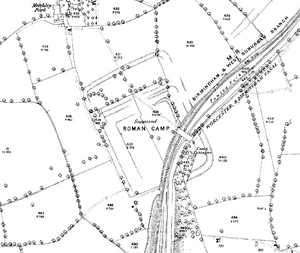Metchley Fort facts for kids
Quick facts for kids Metchley Fort |
|
|---|---|

The site of the fort, pictured here in 2009
|
|
| Lua error in Module:Location_map at line 420: attempt to index field 'wikibase' (a nil value). | |
| Founded during the reign of | Julius Caesar |
| Founded | 43 AD |
| Abandoned | 120 AD |
| Place in the Roman world | |
| Province | Britannia |
| Directly connected to | Icknield Street |
| Location | |
| Place name | Metchley |
| Town | Birmingham |
| County | West Midlands |
| Country | England |
| Reference | |
| UK-OSNG reference | SN643564 |
| Site notes | |
| Discovery year | 18th century |
| Condition | Earthworks, crop marks and ditches |
| Controlled by | Scheduled Monument (SAM: CD129) |
Metchley Fort was a Roman fort located in what is now Birmingham, England. It was built by the Romans soon after they invaded Britain in AD 43. This fort was an important military base for the Roman army.
The fort was built along an old Roman road called Icknield Street. Today, this area is home to the Queen Elizabeth Hospital Birmingham and the University of Birmingham in Edgbaston.
Contents
What Metchley Fort Looked Like
Metchley Fort covered an area of about 200 square meters. It was well-protected by strong defenses. These included a bank made of earth and turf, with a wooden wall on top. There were also towers and two ditches around the fort.
Inside the fort, all the buildings were made of timber (wood). These included places for soldiers to sleep, a building to store grain, a workshop, and other storage areas.
Fort's History: Built and Abandoned
The fort was first built around AD 43. It was used by the Roman army for some time. However, it was left empty around AD 70.
A few years later, the Romans came back and used the fort again. But by AD 120, Metchley Fort was completely abandoned for good.
Civilian Settlement Near the Fort
Next to the fort, there was also a small civilian settlement. This was called a vicus. It was a village where people who were not soldiers lived and worked.
The vicus had wooden buildings and yards. It was located along a road that led from the fort's west gate. This settlement was only used for a few years, mainly when the fort was at its busiest.
Fort Extensions and Uses
The fort was made larger on three sides. These new areas were called annexes. They were used for different purposes.
Soldiers would tie up their horses there. The annexes also provided extra storage space. Some small industries, like working with iron, also took place there. Later, the fort's original buildings were replaced. New structures were built, including fenced areas. This suggests the fort might have become a storage depot for supplies.
Discovering Metchley Fort
People first found remains of the fort in the 18th century. At first, they weren't sure if the earthworks were Roman.
Modern Excavations and Finds
Archaeologists confirmed the fort's age during excavations in the 1930s. This happened when the University of Birmingham Medical School was being built. More digging took place in the 1940s and 1950s.
On September 28, 1953, the Lord Mayor of Birmingham, G. H. W. Griffith, opened a restored part of the fort. This was the north-west corner. Sadly, this reconstruction was later damaged by vandals.
More extensive excavations happened in the 1960s. These digs uncovered many wooden buildings inside the fort. Mick Aston, who later became famous on the TV show Time Team, worked on these excavations in the late 1960s.
Recent Discoveries
In the early 2000s, new discoveries were made. These included old ovens and hearths. They also found wooden gateways and roads. The headquarters building of the fort was also uncovered.
Archaeologists found pottery and vessels from the Severn Valley and the Malvern Hills. They also found tableware that came all the way from France.
Protecting the Fort
The remains of Metchley Fort are very important. It is one of thirteen scheduled monuments in Birmingham. This means it is a protected historical site.


